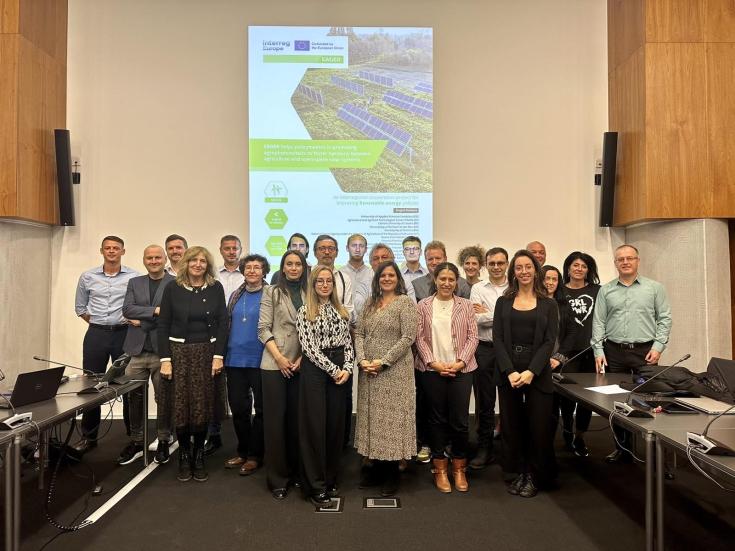Study visit to Lithuania in the framework of EAGER project

In the period of 9th – 10th of October 2024, a study visit within the framework of the EAGER project - “Easing AGrophotovoltaics for EuRope”, co-funded by the Interreg Europe Programme 2021-2027, took place in Vilnius, Lithuania. All project partners, as well as some stakeholders coming from different countries took part in the event.
On the first working day, the event started with a welcome speech by representatives from the National Payment Agency, Lithuania and the Lithuanian Innovation Centre. Reports from Lithuanian stakeholders at national and regional level showcased the development of the agricultural and renewable energy sectors in Lithuania. Domantas Mikelevičius, from the Lithuanian Ministry of Energy explained that “Lithuania's National Energy Independence Strategy aims to ensure the country's full energy independence by 2050” - Lithuania is expected to grow electricity consumption six times and promote its use in different sectors. There are also plans to synchronize the electricity system with European networks and improve energy efficiency. Later, Žilvinas Jasiulevičius from the Lithuanian Ministry of Agriculture presented Lithuania's strategic plan for agriculture for 2023-2027 related to solar energy. The presentation described an implemented policy correction which came into force on 7th of October 2024, which established a description of the unit rates of measures of the strategic plan and their numerical values. The updated rules also aim to simplify administrative procedures for the acquisition of renewable energy production facilities (e.g. solar systems). These updates are expected to help increase the popularity of solar investments by making them more available. Antanas Karbauskas, a spokesman for the European Commission, also made a report about the expected challenges, problems and opportunities related to solar power plants in agriculture systems in the European Union. This was followed by a presentation on the existing financing possibilities for the adaptation of solar power plants in agriculture provided by three different Lithuanian ministries.
Lithuania's regional study was the final presentation for the session which revealed several fundamental problems the sector faces when considering APV, including shading solar panels which affect harvest, infrastructure restrictions in rural areas, and the impact of climate change on agricultural productivity and the efficiency of solar panels systems.
In the afternoon session, each of the project partners presented their policy instrument – what it is about, and the improvements the policy instrument aims to achieve. Partners also presented their good practices identified during the first 6 months of the project. At the end of the first working day, partners discussed pending activities and the next steps of the project.
On the second day, the Lithuanian partners organized several on-site visits to demonstrate innovative solutions and best practices in the area of APV. The tour started with a visit to “The Applied Research Institute for Prospective Technologies”. Interesting research presentations were provided about the institute’s research into solar module testing, integrated energy solutions being developed at the institute, and research being conducted by the Lithuanian Research Centre for Agriculture and Forestry with regards to the impact of (A)PV on crops. After that, partners and stakeholders of EAGER had the opportunity to see the different sections of the laboratory and how different components are being tested and examined for different parameters of productivity.
The second visit was to “Solitek - European Manufacturer of Solar Panels and Batteries”. They produce more than 80% of the solar modules in Vilnius, Lithuania, the geographic centre of Europe. These are exported to Italy, Sweden, Finland, Germany, Netherlands, United States and many other countries. The participants were introduced to all the production stages of the PV manufacturing process and an overview of the quality control performed on the modules was also provided.
The last trip was to the largest vertical farm for microgreens in Europe called “Leafood”. Their output is much larger compared with traditional farms – approximately 1 tonne of greens is harvested daily, arriving at restaurants and supermarkets within hours of being picked. The total surface area of the vertical farm equates to 1.3ha in a warehouse with floor space of 0.35 ha, enabling them to contribute to saving precious natural resources. The system is very environmentally sustainable, no additional heating is required, the use of LED lighting to simulate day/night conditions consumes 70% less energy than the traditional fluorescent light tubes used in similar systems, and 100% green energy supplied from photovoltaics and wind power plants minimizes damage to the environment.